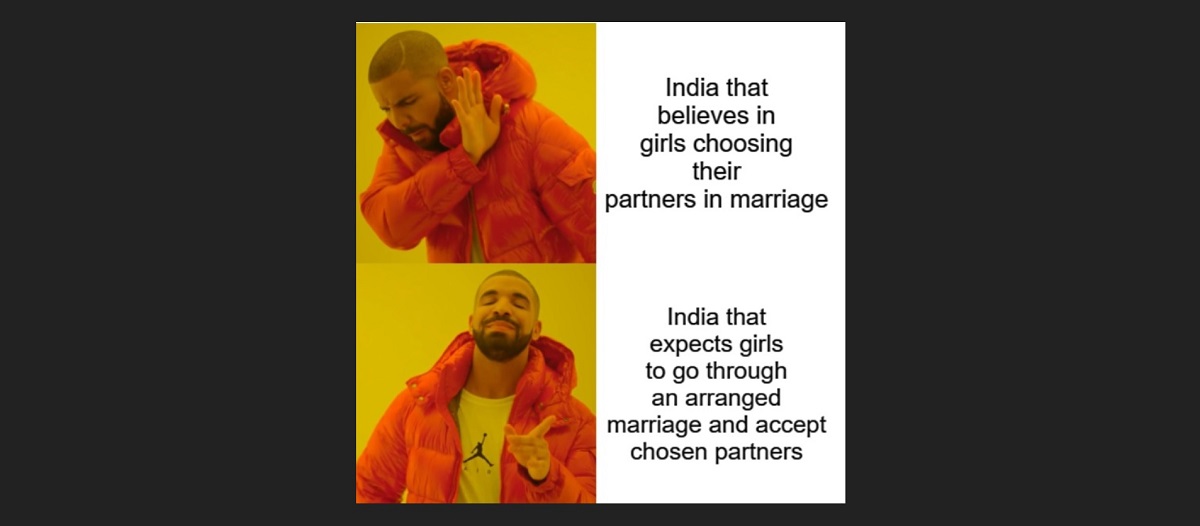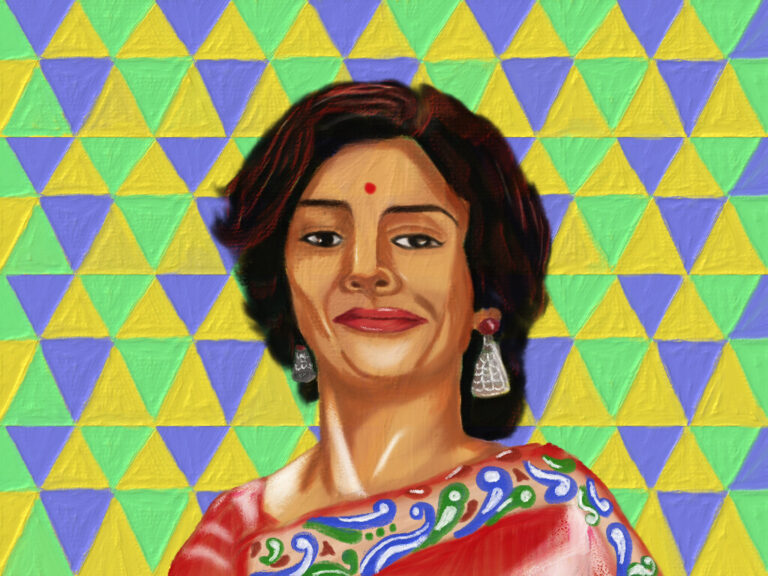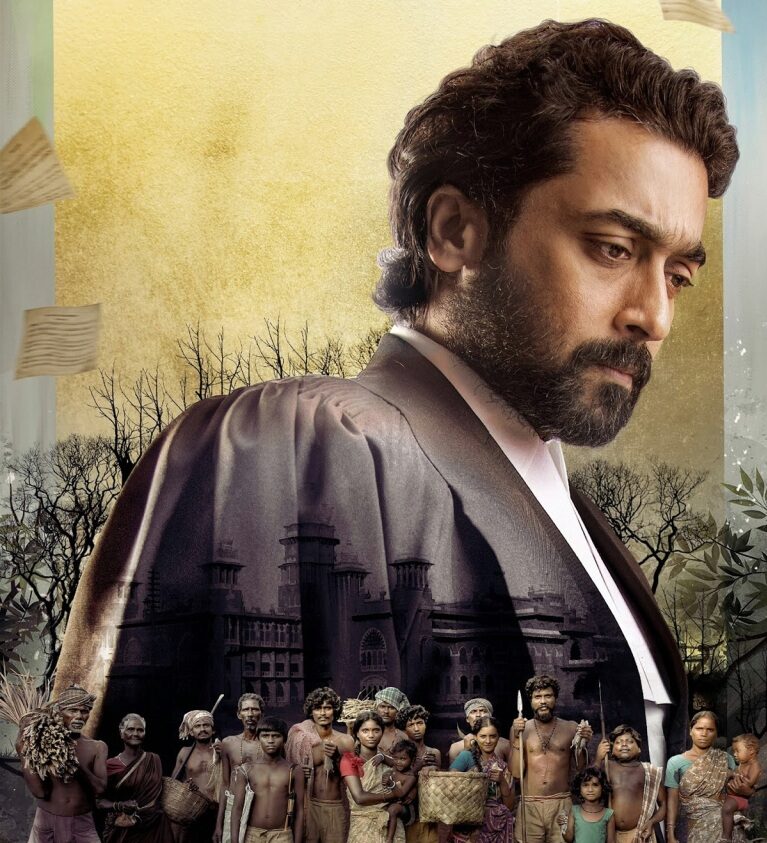Netflix’s documentaries reveal a darker side of Arranged Marriages

Anirban Chanda is a law student at Jindal Global Law School, Sonipat. He is interested in Constitutional Law and Political Theory. Sahil Bansal is a final year law student at Jindal Global Law School. His academic interests include Law, Gender, and History.

Marriage is considered to be one of the many important institutions that ensure social cohesion in a society. The concept of ‘arranged marriages’ has been a popular part of the Indian culture for centuries now.
In India, a noticeable absurdity about ‘arranged’ marriages is the fact that the choice and/or consent of the parties are considered insignificant. Instead, the respective families hijack the entire matchmaking process and negotiate the terms of the nuptial relation. This might seem unreasonable, old-fashioned, and very patriarchal to all those who are not familiar with the customs in India.
Several film-makers have made documentaries and movies which portray the nitty-gritty of arranged marriages in the middle and upper-middle-class families in the country. In the recent past, two such films that have attracted several eyeballs are Netflix’s Indian Matchmaking, and a 2017 documentary titled A Suitable Girl.
This article endeavors to discuss some parts of these two films while exploring major social factors like caste, class, stereotypical preferences, the role of marriage intermediaries, and the decisional autonomy of bachelorette women, all of which continue to remain a dominant force in choosing life partners in India. It may be prudent, to begin with, a synopsis of the two films that we wish to discuss.
A Suitable Girl & Indian Matchmaking
The 2017 documentary, A Suitable Girl, narrates the story of three Indian women, Dipti, Ritu, and Amrita. All three of them are educated, middle-class women. The documentary portrays the complex relationship of marriage, family culture, and kinship in the lives of these three women over the course of four years. The film studies the institution of ‘arranged marriage’ that exists in India and reveals a darker side that usually goes unnoticed.
Netflix’s Indian Matchmaking, on a slightly different footing, explores the institution of arranged marriages in a rather celebratory fashion and, therefore, glosses over the stark realities associated with matchmaking in India and its diaspora. The show, which is currently a home quarantine ‘binge-watch hit,’ films the life of Mrs. Sima Taparia. Mrs. Taparia fondly referred to as ‘Sima Aunty’ in the film series, is one of Mumbai’s most highly paid matchmakers. Her interactions with her elite clients and the latter’s patriarchal preferences for the perfect bride or groom are the foundations of the film’s plot and are also the subject of focus in this article.
The role of Matchmakers and Intermediaries
At different times in the society, a host of diverse occasions and social structures have played an important role in promoting courtships and marriage. It might be interesting to take note of a more regional example – in pre-colonial Bengal, as scholar Madhurima Mukhopadhyay notes, “the matchmaker was called ghatak and the female equivalent ghatki. They functioned within the community as the principal-agent for establishing marriage alliances.” These ‘agents’ extended their services in finding suitable matches on the basis of caste preferences and social status. With the advent of newspapers and the evolution of print media, matrimonial advertisements became a new development that continues to date.[1]
In modern-day India, as is the case in many other parts of the world, a complex network of informal actors like relatives, family friends, and workplace colleagues play an important role in the search for the perfect bachelor or bachelorette. Today the internet and the presence of social media-dating apps (like Tinder) have proven to be more advanced platforms for meeting new people for the purpose of dating and eventually settling down.
Is Sima Taparia’s approach similar to that of the traditional matchmakers?
The answer is both yes and no! Mumbai’s top matchmaker frequently travels abroad to meet her elite clients from the Indian diaspora. [2] This is very different from the traditional matchmakers like the ghataks’ who did not have much access to the del-crème-del of the Indian society and whose clientele was usually limited to the middle-class families.
In addition to this, there lies a huge difference in how Mrs. Taparia introduces the prospective bride and groom. After finding a ‘suitable profile,’ the modern-day matchmaker arranges a meeting between the parties. In popular parlance, these meetings are like ‘dating’ where the prospective bride and groom meet each other at a restaurant, café, or a similar public place in order to interact in person and get to know each other. This practice of pre-marriage dating has become a popular custom for modern Indian youth before they confirm the match. This new urban culture has led to the emergence of what scholar Patricia Uberoi describes as the ‘arranged love marriage.’ [3]
This custom of getting to know each other before marriage was strictly forbidden in the old times where the bride and groom could only meet each other in the presence of the family elders. On this specific issue, Sima Taparia represents the modern Indian matchmakers, who can appreciate the concerns of their present-day clientele and mark an express departure from the age-old conservative methods of matchmaking.
However, at the same time, Mrs. Sima Taparia’s manner of working does exhibit certain traits that resemble the traditional Indian matchmaker. One such example might be her profound belief in astrology and horoscopes. This is apparent from her extensive visits to a face reader and her consultations with various astrologers, both of which have been shown in different episodes of the series. The traditional Indian matchmakers, too, reposed a considerable faith in astrology. The author Rochona Majumdar writes in her book Marriage and Modernity: Family Values in Colonial Bengal (2009) that in the early 20th century Bengal, the belief in horoscopes and astrology was so widespread that many astrologers decided to become full-time ghataks (matchmakers). [4]
In an age where dating apps and marriage bureaus dominate the field of marriage intermediaries, Sima Aunty confidently remarks that apps like Tinder and Bumble cannot compete with her approach since she personally meets her clients and studies their socio-economic background while picking up the ‘unspoken’ traits of the family, something that a smartphone software cannot do. [5] While her spirit is applaudable, we are disappointed to see how she leaves her clients to the mercy of destiny. In her own words, “…all my efforts are useless if the stars are not aligned.” [6]
How do Matchmakers and Matrimonial Advertisements promote regressive stereotypes?
Indian traditions have always had a deep imprint of caste. While social status or class was an equally important factor in forging marital ties, its importance has become more prominent in the last few decades.
In most cases, class and caste determine the platforms or intermediaries that a particular family adopts in order to find a suitable prospect for their bachelor or bachelorette. The documentary A Suitable Girl opens with a scene where Dipti, one of the three bachelorette protagonists, is shown to scrutinize the matrimonial columns of the regional newspaper in search for a ‘good match.’ Dipti belongs to a middle-class family and resides in the outskirts of Mumbai. [7] Interestingly, research shows that a considerable percentage of bachelorette girls from middle-class families, like Dipti, check the matrimonial columns and newly emerging marriage websites in their search for a suitable profile. (Uberoi, 2006)
What is both astonishing and lamentable is the fact that the modern youth of our country continue to attribute great importance to caste, something that is easily noticeable upon a casual glance over the matrimonial columns of any regional newspaper. [8] In the past, arranged marriages were marked by the regressive practice of endogamy. Madhurima Mukhopadhyay’s work records that several regional newspapers in the Indian metros like Kolkata still carry advertisements inviting alliances from castes other than SCs, STs, and OBCs. (Mukhopadhyay, 2012)
In a recent article, sociologist Professor Parul Bhandari, who has authored the book Matchmaking in Middle-Class India: Beyond Arranged and Love Marriage, informs us that it is very common to find matrimonial newspaper advertisements that express their preference for ‘fair-skinned’ and ‘modern-yet-traditional wives.’ The scholar adds that films like ‘Indian Matchmaking’ tell us that in the present day, casteism is not just limited to the rural and backward parts of the country but is prevalent across all sections of the modern-urban dwellers who reside in the cities. [9] It is very unfortunate to note that modern matchmakers like Mrs. Sima Taparia promote such regressive social practices by taking them into consideration. In her words, ‘adjustment’ and ‘compromise’ are the two secret mantras to finding a suitable match.
Increase in Agency for educated and financially independent middle-class women
Marriage as a social institution is a very important subject that can be used to study the agency of women in society. Several academics and scholars have pointed out, time and again, that agency is not just the power to take decisions – it is far more important to study whether the socio-cultural surroundings allow the individual to freely exercise her choice and act upon it. [10]
The films A Suitable Girl and Indian Matchmaking portray different characters who exhibit their decisional autonomy in varied forms. On one end of the spectrum, we have Dipti, the middle-class bachelorette, who believes that marriage is an essential part of a woman’s life. [11] The post-structural school of feminist thought would explain Dipti’s life as one where the girl is brought up to believe that only marriage can ensure her future happiness. This made her think that she had no other means to exercise her agency. [12]
On the other hand, we are introduced to Ankita in the film Indian Matchmaking. Ankita is an upper-middle-class bachelorette living in Delhi. She is a financially-independent entrepreneur looking for a marriage that involves equal partnership. At the end of the film, we find that Ankita realizes the ugly side of arranged marriages and rejects the regressive ‘terms and conditions’ of adjustment and compromise. She decides to remain happily unmarried. One could perhaps say that her socio-economic background and surroundings allowed her to exercise her agency more freely than someone like Dipti.
Therefore, it seems that with changing times, we have a considerable percentage of educated, liberal, financially-independent, middle-class Indian women who do not believe that marriage is an important part of life. However, we must remember that this free exercise of agency is limited to this particular class only.
Conclusion:
In this article, we have attempted to discuss some of the major social factors that influence arranged marriages in India. Throughout this piece, we explore the romantic choices reflected in the society and question our commitment in critiquing these regressive and patriarchal social structures. Whether the above-mentioned films that hold a mirror to our society will knock on our conscience and contribute to a better and progressive India is something that remains to be seen.
References
1. Mukhopadhyay M. (2012). Matchmakers and Intermediation: Marriage in Contemporary Kolkata. Economic & Political Weekly. Volume XLVII No. 43. Retrieved August 28, 2020, from http://www.jstor.org/stable/41720304
2. Masih, N. (2020, August 25), In the spotlight with a Netflix show, India’s elite matchmakers reinvent an age old tradition. The Washington Post. Retrieved August 29, 2020, from:https://flipboard.com/@WashPost/in-the-spotlight-with-a-netflix-show-india-s-elite-matchmakers-reinvent-an-age-/a-ILTINYb_TCWpdBn7NODclQ%3Aa%3A419161690-6302b03168%2Fwashingtonpost.com
3. Uberoi, P. (2006). Freedom and Destiny, Gender, Family and Popular Culture in India. New Delhi: Oxford University Press.
4. Majumdar, R. (2009). Marriage and Modernity. Family Values in Colonial Bengal. New Delhi: Oxford University Press.
5. Editor (2020, July 22). Sima Taparia opens up on her matchmaking process, Netflix show, and why dating apps can’t ‘compete’ with her. Firstpost. Retrieved August 29, 2020,from: https://www.firstpost.com/entertainment/sima-taparia-opens-up-on-her-matchmaking-process-netflix-show-and-why-dating-apps-cant-compete-with-her-8625711.html
6. Rai, S. (2020, July 24). Controversial matchmaking show helps Netflix in the battle for India. Hindustan Times. Retrieved August 29, 2020, from:https://www.bloombergquint.com/technology/netflix-s-reality-series-on-roving-indian-matchmaker-goes-viral
7. Hussain, N. (2020, August 7). Reviewing ‘A Suitable Girl’: Move Over ‘Indian Matchmaking’ To See The Bigger Picture. Feminism in India. Retrieved on August 29,2020,from:https://feminisminindia.com/2020/08/07/review-a-suitable-girl-indian-matchmaking-sima-taparia/
8. Waghmore, S. (2015, May 30). Prejudice disguised as politeness. The Hindu. Retrieved August 29, 2020, from: https://www.thehindu.com/opinion/op-ed/harrish-iyer-in-the-eye-storm-for-placing-a-matrimonial-advertisement/article7261345.ece
9. Bhandari, P. (2020, July 21). Matchmaking illustrates the ills of Indian society. Hindustan Times. Retrieved on August 29, 2020, from:https://www.hindustantimes.com/analysis/matchmaking-illustrates-the-ills-of-indian-society-analysis/story-6YJNaptYn0Ue8fBqRLaDPJ.html
10. Wheatney, S. (2019). The Idea of International Human Rights Law. Oxford University Press.
11. Sonawane, M. (2018, December 17). Why is Marriage An Ultimatum For Women?. Feminism in India. Retrieved on August 29, 2020, from:https://feminisminindia.com/2018/12/17/marriage-ultimatum-women/
12. Davies, B. (1991). The Concept of Agency : A Feminist Poststructuralist Analysis. Social Analysis: The International Journal of Social and Cultural Practice, (30), 42-53. Retrieved August 28, 2020, from http://www.jstor.org/stable/23164525








